In 2017, Harvard University geneticist George Church predicted that within two years he would have succeeded in making genetically modified elephant embryos resemble those of the woolly mammoth. The resurrection of these iconic ice age giants is the most popular example of the concept of species de-extinction, the possibility of bringing vanished species back to life. But with the expiry of Church’s two-year deadline, has his prediction been fulfilled? What’s more, is mammoth de-extinction even feasible? And if it were, would it be desirable?
The cloning of Dolly the sheep in 1996 popularized a new technology whose possible application to the de-extinction of species soon entered the scientific debate. In 2009, Spanish and French researchers cloned an extinct animal for the first time, the bucardo (Capra pyrenaica pyrenaica), although the offspring did not survive. The cloning of a mammoth by the Dolly method would require recovering intact genetic material from a cell, which would be transferred to an ovule (egg) from a related animal, such as the elephant, and then implanting the resulting embryo into the uterus of a female elephant.

This was the goal announced in 2011 by Akira Iritani, a biotechnologist from the University of Kinki (Japan). According to the researcher, the recovery of remains of frozen mammoths in Siberian permafrost opened the door to obtaining viable cell nuclei for cloning. Iritani set a five-year horizon, which then caught the attention of the media. But the deadline passed and the cloned mammoth did not arrive. Last March, the Japanese scientist and his collaborators published the discovery of signs of biological activity in the nuclei of mammoth cells recovered from Yuka, a female that was frozen 28,000 years ago. However, the study authors themselves acknowledged: “The results presented here clearly show us again the de facto impossibility to clone the mammoth by current nuclear transfer technology.
The mammophant
The truth is that, in practice, the idea is infinitely more complicated than on paper, since the genetic material of these samples is broken into pieces. “To date, a very large number of exceptionally well-preserved mammoth remains have been tested using DNA technology, by my research group as well as those of my colleagues,” paleogeneticist Love Dalén of the Swedish Museum of Natural History tells OpenMind. “The results unanimously show that the genomes in these samples are degraded into many tens of millions of fragments. And there is no way to put these back together (in the right order).” For the researcher, “classic cloning is out of the question.”

But cloning is not the only technique being proposed for the recovery of the woolly giants. In 2015, the team led by Dalén obtained the complete sequence of the mammoth genome. Thanks to the knowledge of the genes of this species and with the support of the Revive & Restore initiative, that same year Church launched the project to modify the DNA of the Asian elephant —the closest living relative of the mammoth— to obtain a hybrid animal similar to a mammoth, which has come to be known as a mammophant.
Specifically, Church seeks to modify the genes involved in the adaptation to the cold of the blood, fur and body fat. The technique consists of applying the CRISPR genetic editing tools to the DNA of Asian elephant skin cells, and then transforming them into stem cells capable of generating an embryo. In 2017, Church said he had already modified 45 elephant genes. However, it is evident that his two-year prediction has not been met; in fact, to date the researcher has not published any study related to it, and the Revive & Restore website only mentions that “a number of genes have been successfully rewritten into Asian elephant cell lines.”
But according to Dalén, this approach also presents obstacles that make it “very difficult, if not impossible.” Firstly, the person responsible for the mammoth genome warns that certain fragments of this animal’s DNA have yet to be discovered, as its sequence has been assembled on the basis of that of the elephant. “If mammoth-specific genes existed and were important in order to resurrect the species, bringing the mammoth back would not work,” he warns. What’s more, it should be noted that Church has only modified 45 genes, but there are thousands, along with their regulatory sequences, which are different in mammoths and elephants.

This is by no means the only impediment. Whichever route is chosen to try to create a mammoth, all of them would go through the implantation of an embryo in the uterus of an elephant. “Leaving aside the many ethical reasons why this is a bad idea (elephants are after all endangered), there are good reasons that it might not work anyway,” says Dalén. Given they are different species, separated by millions of years of evolution, there is a good chance that any gestation would end in a miscarriage. To address this problem and avoid ethical objections, Church has proposed resorting to an “artificial uterus” —something that, with today’s technology, simply does not exist.
Back to the Ice Age
Nor are all objections to the resurrection of mammoths purely technical. Some experts in ecology and conservation doubt not only the viability of introducing these animals into nature, but also the appropriateness of doing so. A frequent argument is that the former mammoth habitat no longer exists today. Since 1996, Russian scientists Sergey and Nikita Zimov, father and son, have been maintaining the Pleistocene Park in Siberia, a 144-square-kilometre nature reserve in which they have released large herbivores to try to restore the ancient herbaceous tundra of the Ice Age.
Nikita Zimov, who is responsible for the park’s development, told OpenMind: “We introduced some types of animals which haven’t been in this area for 15,000 years or even ever, and showed that they are capable of adapting to a new environment.” The Zimovs’ hypothesis is that the grasslands disappeared when hunting eliminated the herbivores that maintained them; therefore, they argue, by reintroducing them, the grasslands will return. “We see that the idea is working and it is possible to convert from low productive ecosystems into the high productive,” he says.

The Zimovs also suggest that their project can contribute to the fight against climate change: grasslands, cooler than forests, will help keep permafrost frozen, thus preventing the release of greenhouse gases. “We are gathering the data to prove the idea that old ecosystems will be more beneficial in terms of climate,” says Zimov.
The Pleistocene Park has been the focus of mammoth extinction projects for years. Specifically, Zimov has maintained contacts with Church, although “rather verbal,” he says. But although this collaboration is still preliminary, for the Russian scientist his park offers a raison d’être for cloning projects. “The more diverse the ecosystem, the better it is, so with mammoths our ecosystem would be more effective and aggressive; we would welcome the mammoth or cold adapted elephant in the park.”
However, not all experts buy the idea. Ecologist Alexandre Robert, from the National Museum of Natural History in Paris, told OpenMind: “It seems that the effects of the return of large herbivores to the steppes of northern Russia have been experimentally tested,” but the biologist is sceptical about the possible effect on the climate: “I do not think that we can reasonably extrapolate that the benefit of these animals on melting permafrost can have significant effects on global warming at the biosphere level.”
Comments on this publication